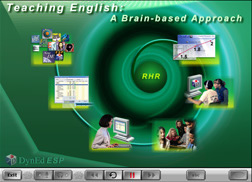Teaching English: A Brain-based Approach

Teaching English: A Brain-based Approach is a professional training course for teachers of English (ESL/EFL) who wish to blend technology into their teaching. DynEd's brain-based, blended approach to language learning is built around a cognitive, neuroscientific learning theory called Recursive Hierarchical Recognition, or RHR. This learning theory differentiates DynEd's blended approach from other computer-assisted language learning (CALL) approaches which may or may not involve teachers and classroom support.
In addition to introducing the RHR learning theory, this award-winning course gives hands-on experience with computer-based lessons, lesson plans for in-class activities, and develops English language proficiency for English teachers who need to improve their own English.
This course is also suitable for graduate teacher training programs that need to better prepare teachers to use technology for language learning (CALL), and to explore a cognitive neuroscientific approach that is being widely used.
Overview
Written by Lance Knowles, and based on the teacher training program developed for DynEd clients and trainers, Teaching English: A Brain-based Approach is divided into 7 units. The course assumes a reasonable level of English language fluency. Teachers below DynEd Placement Level 1.7 should use DynEd's other courses to prepare for this course. An Instructor's Guide is available.

Some key areas covered in this teacher-training course include:
- defining roles of teacher and technology in the blended model
- "temporal tension" and developing the oral skills
- automaticity and language chunking
- language sequencing and conceptual frameworks
- setting up neural learning cycles to accelerate language acquisition
- defining and testing language fluency
- lesson plans and classroom activities
- distributed versus mass learning to promote skill acquisition
- procedural, long-term, and working memories in relation to language acquisition
- measuring progress and effective use of courseware
Course Structure
| Unit 1 | Unit 2 | Unit 3 |
|---|---|---|
| Introduction to RHR Learning Theory and Language Learning Exercises | Placement Tests and Learning Path Orientation and Practice | How to Study: Orienting and Coaching Students to Effective Practice |
| Unit 4 | Unit 5 | Unit 6 |
| The Blended Approach: Extension Activities for the Classroom | The Records Manager, Monitoring Progress, and Data Analysis | The Intelligent Tutor, Study Scores, and Study Path Management |
| Unit 7 | ||
| Courseware Overview: Differentiating and Presenting DynEd Courseware | ||
Based on my experience as a teacher and teacher trainer, I believe that the RHR learning theory is very useful for teachers - especially as they begin to use technology. It helps us solve many problems, and is very motivating for teachers and students.
My only regret is that I didn't know about this theory many years ago. I recommend it highly as a real advance in language teaching, and as something that should become an integral part of teacher training programs. I'm proud to be a part of this process." More...
Vera Semenova
Methodologist, Teacher Retraining Institute
Sakha Republic (Yakutia) Russian Federation
For more information, please contact us and specify your interest in Teacher Training.
Copyright © 2024 DynEd International, Inc. All rights reserved
Apple, iPad, iPhone, iPod touch, and iTunes are trademarks of Apple Inc., registered in the U.S. and other countries. App Store is a service mark of Apple Inc.
Windows is a registered trademark of Microsoft Corporation in the United States and other countries.
Android and Google Play are trademarks of Google Inc. The Android robot is reproduced or modified from work created and shared by Google and used according to terms described in the Creative Commons 3.0 Attribution License.
BlackBerry is a registered trademark of Research in Motion Limited. BlackBerry World is a trademark of Research in Motion Limited.

